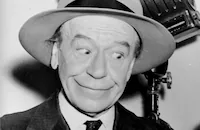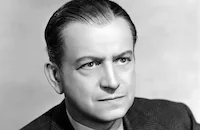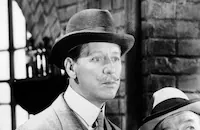The Return of Frank James

Brief Synopsis
Cast & Crew
Fritz Lang
Henry Fonda
Gene Tierney
Jackie Cooper
Henry Hull
John Carradine
Film Details
Technical Specs

Synopsis
After the tragic Northfield, Minnesota robbery, in which several members of their gang are killed, the outlaw James brothers split up and Frank disappears to the Missouri countryside. There, using the name Ben Woodsen, he farms the land with his friends, Pinky and Clem, the son of one of the gang members. One day, Frank learns that his brother Jesse has been shot in the back by one of the Ford brothers, who have been sentenced to hang for their crime. Frank is resolved to let the law deal with the Fords until he reads that they have been pardoned and awarded money for their cowardly crime. Determined to exact justice for the murder of his brother, Frank rides after the Fords, who hastily depart for the West. To fund his crusade, Frank robs the railroad express office, rationalizing that it was railroad money that killed his brother. Frank's plans go awry, however, when Clem appears and insists that he join Frank. In the chaos, the watchman is killed and Frank is accused of the murder. In retaliation, McCoy, the head of the railroad, offers a reward for Frank, and his henchman, George Runyan, follows the Ford boys West, knowing that Frank will not be far behind. In Denver, Frank and Clem fabricate the story of Frank's demise, which is picked up by aspiring young newspaper reporter Eleanor Stone and printed in her father's paper. Meanwhile, Frank tracks down the Fords and in a frantic pursuit, Charlie Ford falls from a cliff and dies. While Frank is out of town, Runyan appears and identifies Ben Woodsen as Frank James. After eluding Runyan, Frank is about to ride after Bob Ford when Eleanor informs him that Pinky has been arrested for the freight office robbery and sentenced to hang. Torn between avenging his brother's murder and returning to Missouri to save his friend, Frank's conscience wins out and he rides to Missouri, where he is arrested and put on trial for murder. Frank's old friend, Major Rufus Todd, the town newspaper editor, defends him by casting the trial in terms of a war between the railroad and the farmers, the North and the South. Just as the jury, composed of Southern farmers, finds Frank innocent, Bob Ford appears and runs from the courtroom. In his flight, he kills Clem, but the boy fatally wounds Ford. With his brother's death avenged, Frank begins life anew.

Director

Fritz Lang
Cast

Henry Fonda

Gene Tierney

Jackie Cooper

Henry Hull

John Carradine

J. Edward Bromberg

Donald Meek

Eddie Collins

George Barbier
Ernest Whitman
Charles Tannen
Lloyd Corrigan

Russell Hicks
Victor Kilian

Edward Mcwade
George Chandler

Irving Bacon
Frank Shannon

Barbara Pepper
Louis Mason
Stymie Beard
William Pawley
Frank Sully
Davidson Clark
Crew
Travis Banton
George Barnes
Joe Behm
David Buttolph
Larry Chapman
Frank Corey
Richard Day
George Dye
W. D. Flick
Kenny Green
Charlie Hall
Sam Hellman
Roger Heman
Bert Hendrickson
Hal Herman
Louis Hippe
Wiard B. Ihnen
Wendell Jones
Natalie Kalmus
Ed Ledgerwood
Thomas Little
Roger Mace
Kenneth Macgowan
George Mchose
Jack Mckinsey
Walter Myron
Morgan Padelford
Fred Rezk
C. E. Richardson
Herbert Romey
Aaron Rosenberg
Stanley Scheuer
Ben Silvey
William V. Skall
Fred Smith
Walter Thompson
Wesley Trist
Anthony Ugrin
Paul Uhl
Jack Warren
Jack Young
Darryl F. Zanuck

Film Details
Technical Specs

Articles
The Return of Frank James
She fell short of that goal, but Fonda appreciated how hard she was trying, and that put her at ease. Playing it safe, however, she spent all her evenings in a studio projection room, studying movie after movie in search of screen-acting tips. Her campaign paid off. She gives a smart and spirited performance in a somewhat underwritten role, making a solid impression in her own right while gracefully supporting Fonda's more full-bodied acting as the title character.
This was Fonda's second appearance as Jesse James's big brother. The first was in Zanuck's hit Jesse James a year earlier, where Tyrone Power's eponymous outlaw died as the real Jesse did, shot in the back in his own living room by his treacherous friend Robert Ford. The Return of Frank James does all it can to capitalize on the earlier film's success. In addition to Fonda, returning cast members include Henry Hull as Major Rufus Cobb, a newspaper editor; Donald Meek as McCoy, a railroad tycoon; J. Edward Bromberg as Runyan, who wants to collect the reward for tracking Frank down; Charles Tannen as Bob Ford's brother; and John Carradine as Bob Ford, the bounty hunter who shot Jesse down. All are first-rate character actors having fun with parts that seem tailor-made for them.
The Return of Frank James starts with a quick replay of Jesse's death. Then it shifts to the Missouri countryside, where Frank has been living under an alias ever since he and Jesse split up. Their last job was a Minnesota robbery in which several of their partners were killed or caught, and after that Frank understandably hung up his guns for good. He's now a peaceful farmer, tilling the land with help from Clem (Jackie Cooper), the adolescent son of a former gang member, and Pinky (Ernest Whitman), an African-American cook, jokester, and assistant.
When he learns that Jesse has been killed by the Ford brothers, Frank calmly tells Clem that he's content to let the law catch and punish the evildoers. But when word arrives that the Fords won't hang - they've been given a full pardon, and a reward to boot - he straps on his six-shooter and rides off to take revenge, trailed by Clem, who refuses to stay home. Frank robs a railroad office to finance his mission, but everything goes wrong and a watchman is inadvertently killed. The head of the railroad puts a price on Frank's head, so Frank and Clem spread a cover story that Frank himself is dead - and the story gets printed by Tierney's character, Eleanor Stone, a pretty reporter whose father owns a local newspaper. The climax is a suspenseful courtroom scene that highlights the antagonism between North and South that persisted twenty years after the Civil War, when this story takes place.
There's plenty of drama in The Return of Frank James, but not a lot of real-world history. It's true that Frank went straight and lived peaceably in Missouri after the bungled Minnesota job. But he turned himself in a few months after Jesse died, undergoing two trials and being acquitted each time. Both of the Ford brothers were deceased by then, and Frank had nothing to do with their deaths. As originally planned, the movie had a romantic angle involving Frank and Eleanor, but the studio scratched this because of worries that Frank James's real-life survivors might file a lawsuit. Having a railroad mercenary named Runyon dog Frank's trail throughout most of the story was Zanuck's idea, designed to inject the extra intensity that, in his view, lifts outstanding westerns like Jesse James and John Ford's then-recent Stagecoach (1939) above the rest of the herd.
Lang was an unlikely choice of director for this picture. For one thing, Fonda had hated working with him on You Only Live Once in 1937. For another, Lang was a German émigré, and Hollywood wasn't sure he could handle a genre as all-American as the western (little did they know that spaghetti westerns were only a couple of decades away). Lang was confident in his abilities, and in a 1959 interview with Cahiers du cinéma he explained why he felt so in tune with westerns: "They are based on a very simple and essential ethical code....Even with Shakespeare the moral is simple. The struggle of good against evil is as old as the world."
The Return of Frank James, which was Lang's first western as well as his first film in color, confirms that he was entirely up to the task. It excels on the level of action and also on the level of morality, especially when Frank makes a hard sacrifice to save Pinky from a false murder charge, thus underscoring the fundamental goodness beneath his outlaw ways. Another superb scene shows Frank's agony as he watches the Ford brothers reenact Jesse's death on a theater stage for paying customers, a particularly bitter episode in the James brothers' saga. Still and all, Lang drove Fonda crazy a second time, by reshooting chase scenes and fussing for hours over artificial cobwebs in a barn. His efforts pay off extremely well, however, and he went on to direct Western Union in 1941 and Rancho Notorious, with his compatriot Marlene Dietrich, in 1952.
New York Herald Tribune reviewer Robert W. Dana wrote that Lang's "methodical direction" makes the picture move more slowly than the average outdoor drama, but added that the "emphasis on small things like gestures and shadows and sounds of nature reveal the Western in a new and interesting light." The influential New York Times critic, Bosley Crowther, had decidedly mixed feelings, calling the picture a "handsome and spacious affair" and praising Fonda for his "accustomed honesty and understatement" while complaining that "in drama [the film] is lacking" and finding Tierney's acting "mannered and colorless." Regardless of such criticism, the picture successfully launched Tierney's screen career, and in her memoir she seems more amused than upset about another critique she received. "For my performance in The Return of Frank James," she recalled, "I was honored by the Harvard Lampoon as The Worst Female Discovery of 1940....I did not feel undeserving of the award...."
Director: Fritz Lang
Producer: Darryl F. Zanuck
Screenplay: Sam Hellman
Cinematographer: George Barnes
Film Editing: Walter Thompson
Art Direction: Richard Day, Wiard B. Ihnen
Music: David Buttolph
With: Henry Fonda (Frank James), Gene Tierney (Eleanor Stone), Jackie Cooper (Clem), Henry Hull (Major Rufus Cobb), John Carradine (Bob Ford), J. Edward Bromberg (George Runyan), Donald Meek (McCoy), Eddie Collins (Station Agent), George Barbier (Judge), Russell Hicks (Prosecutor), Ernest Whitman (Pinky), Charles Tannen (Charlie Ford), Lloyd Corrigan (Randolph Stone), Victor Kilian (Preacher), Edward McWade (Colonel Jackson), George Chandler (Roy), Irving Bacon (Bystander), Frank Shannon (Sheriff), Barbara Pepper (Nellie Blane), Louis Mason (Watchman), Stymie Beard (Mose), William Pawley (Actor), Frank Sully (Actor), Davidson Clark (Officer)
C-92m.
by David Sterritt

The Return of Frank James
Quotes
There ain't no right for us poor people than the end of a gun.- Frank James
Trivia
The studio bought the rights to the James Brothers' lives, but changed the facts for entertainment. Although Frank surrendered 6 months after Jesse's murder, both Ford brothers were already dead and Frank had nothing to do with their deaths.
The original treatment had Frank romantically interested in the reporter played by Gene Tierney, but the studio became fearful of a possible lawsuit by Frank's widow and/or son, so it was eliminated from the script.
Notes
Although onscreen credits list David Buttolph as music director, earlier official billing sheets credited Alfred Newman with that role. According to materials contained in the Twentieth Century-Fox Produced Scripts Collection at the UCLA Theater Arts Library, Sam Hellman's original treatment for this film was based on a "story pattern" by Nunnally Johnson. In story conferences, producer Darryl Zanuck proposed that Frank James should be hounded by the character of George Runyan from the film's opening to its close. Zanuck theorized that the difference between "outstanding" westerns like Stageocach and Jesse James and merely ordinary westerns resided in their "clever treatment and adaptation." Zanuck also suggested that Sam Hellman write a rough draft continuity because of his familiarity with the story.
Although the studio bought the rights to the James brothers lives, the real life that Frank James led was quite different from that told in the film. The real Frank surrendered six months after Jesse's murder, after living a peaceful life in Missouri. He was tried and acquitted twice. Neither of the Ford brothers were alive at the time of Frank's surrender, and Frank played no part in the death of either Ford. In the original story outline, Frank was romantically interested in reporter Eleanor Stone, but the studio, fearful of a libel suit by either Frank's widow or son, decided to eliminate the romantic interest. The film was shot on location in Bishop, CA. It was a sequel to Fox's 1939 film Jesse James. Henry Fonda, Henry Hull, John Carradine, J. Edward Bromberg, Donald Meek, Ernest Whitman, Charles Tannen and George Chandler reprised the roles that they played in the earlier film. This film also marked Gene Tierney's screen debut.














